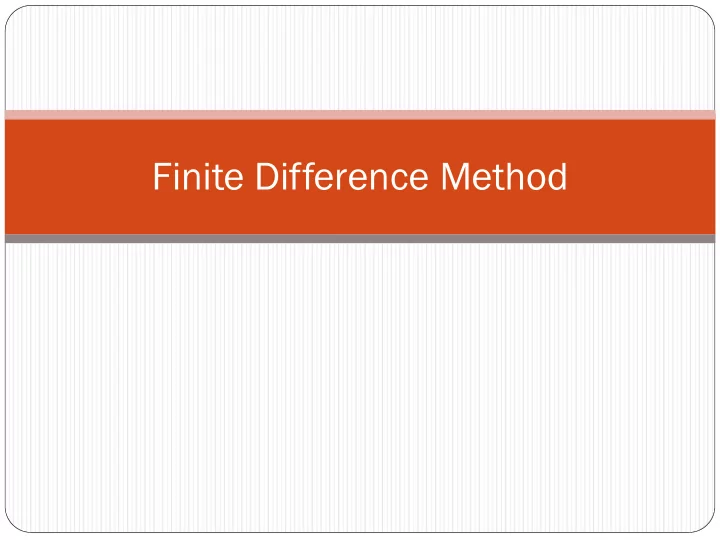

Finite Difference Method
Motivation For a given smooth function 𝑔 𝑦 , we want to calculate the derivative 𝑔′ 𝑦 at a given value of 𝑦. Suppose we don’t know how to compute the analytical expression for 𝑔′ 𝑦 , or it is computationally very expensive. However you do know how to evaluate the function value: We know that: 𝑔 𝑦 + ℎ − 𝑔(𝑦) 𝑔′ 𝑦 = lim ℎ !→# ! "#$ %! " Can we just use 𝑔′ 𝑦 ≈ as an approximation? How do we choose ℎ ? $ Can we get estimate the error of our approximation?
Finite difference method For a differentiable function 𝑔: ℛ → ℛ , the derivative is defined as: 𝑔 𝑦 + ℎ − 𝑔(𝑦) 𝑔′ 𝑦 = lim ℎ !→# Taylor Series centered at 𝑦 , where ̅ 𝑦 = 𝑦 + ℎ ! ! ! " 𝑔 𝑦 + ℎ = 𝑔 𝑦 + 𝑔 $ 𝑦 ℎ + 𝑔′′ 𝑦 % +𝑔′′′ 𝑦 & + ⋯ 𝑔 𝑦 + ℎ = 𝑔 𝑦 + 𝑔 $ 𝑦 ℎ + 𝑃(ℎ % ) We define the Forward Finite Difference as: Therefore, the truncation error of the forward finite difference approximation is bounded by:
In a similar way, we can write: 𝑔 𝑦 − ℎ = 𝑔 𝑦 − 𝑔 ! 𝑦 ℎ + 𝑃(ℎ " ) → 𝑔 ! 𝑦 = 𝑔 𝑦 − 𝑔 𝑦 − ℎ + 𝑃(ℎ) ℎ And define the Backward Finite Difference as: 𝑒𝑔 𝑦 = 𝑔 𝑦 − 𝑔 𝑦 − ℎ → 𝑔 ! 𝑦 = 𝑒𝑔 𝑦 + 𝑃(ℎ) ℎ And subtracting the two Taylor approximations # ! # " 𝑔 𝑦 + ℎ = 𝑔 𝑦 + 𝑔 ! 𝑦 ℎ + 𝑔′′ 𝑦 " +𝑔′′′ 𝑦 $ + ⋯ # ! # " 𝑔 𝑦 − ℎ = 𝑔 𝑦 − 𝑔 ! 𝑦 ℎ + 𝑔′′ 𝑦 " −𝑔′′′ 𝑦 $ + ⋯ 𝑔 𝑦 + ℎ − 𝑔 𝑦 − ℎ = 2𝑔 ! 𝑦 ℎ + 𝑔′′′ 𝑦 ℎ % 6 + 𝑃(ℎ & ) 𝑔 ! 𝑦 = 𝑔 𝑦 + ℎ − 𝑔 𝑦 − ℎ + 𝑃(ℎ " ) 2ℎ And define the Central Finite Difference as: 𝑒𝑔 𝑦 = 𝑦 + ℎ − 𝑔 𝑦 − ℎ → 𝑔 ! 𝑦 = 𝑒𝑔 𝑦 + 𝑃(ℎ " ) 2ℎ
How accurate is the finite difference approximation? How many function evaluations (in additional to 𝑔 𝑦 )? Forward Finite Difference: ' ()# *' ( → 𝑔 ! 𝑦 = 𝑒𝑔 𝑦 + 𝑃(ℎ) Truncation error: 𝑃(ℎ) 𝑒𝑔 𝑦 = # Cost: 1 function evaluation Backward Finite Difference: → 𝑔 ! 𝑦 = 𝑒𝑔 𝑦 + 𝑃(ℎ) ' ( *' (*# Truncation error: 𝑃(ℎ) 𝑒𝑔 𝑦 = # Cost: 1 function evaluation Central Finite Difference: → 𝑔 ! 𝑦 = 𝑒𝑔 𝑦 + 𝑃(ℎ " ) Truncation error: 𝑃(ℎ " ) 𝑒𝑔 𝑦 = ' ()# *' (*# "# Cost: 2 function evaluation2 Our typical trade-off issue! We can get better accuracy with Central Finite Difference with the (possible) increased computational cost. How small should the value of 𝒊 ?
Example 𝑓𝑠𝑠𝑝𝑠 ℎ 𝑔 𝑦 = 𝑓 $ − 2 𝑔′ 𝑦 = 𝑓 $ We want to obtain an approximation for 𝑔′ 1 𝑒𝑔𝑏𝑞𝑞𝑠𝑝𝑦 = (𝑓 $%! −2) − (𝑓 $ −2) ℎ Truncation error 𝑓𝑠𝑠𝑝𝑠(ℎ) = 𝑏𝑐𝑡(𝑔′ 𝑦 − 𝑒𝑔𝑏𝑞𝑞𝑠𝑝𝑦)
Example Should we just keep decreasing the perturbation ℎ , in order to approach the limit ℎ → 0 and obtain a better approximation for the derivative?
Uh-Oh ! What happened here? 𝑔 𝑦 = 𝑓 $ − 2, 𝑔′ 𝑦 = 𝑓 $ → 𝑔′ 1 ≈ 2.7 Forward Finite Difference 𝑒𝑔 1 = 𝑔 1 + ℎ − 𝑔(1) ℎ
When computing the finite difference approximation, we have two competing source of errors: Truncation errors and Rounding errors 𝑒𝑔(𝑦) = 𝑔 𝑦 + ℎ − 𝑔(𝑦) ≤ 𝜗 + |𝑔 𝑦 | ℎ ℎ
Loss of accuracy due to rounding Minimize the total error 𝑓𝑠𝑠𝑝𝑠 ~ 𝜗 + |𝑔 𝑦 | 𝑓𝑠𝑠𝑝𝑠~𝑁 ℎ Optimal “h” Truncation error: + 𝑁ℎ ℎ Gives 𝑓𝑠𝑠𝑝𝑠~ 𝜗 & |𝑔 𝑦 | ℎ = 𝜗 + |𝑔 𝑦 |/𝑁 Rounding error: ℎ
Recommend
More recommend